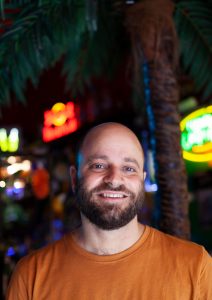Theatre Maker Victor Esses talks about his autobiographical show ‘Where to Belong’ due to tour the UK

Sound has the power to shift mood, heal and evoke memory, soundtracks shaping many of our lives. Presenting an autobiographical one man show incorporating this element, as well as fusing projection and photography, theatre maker Victor Esses presents Where to Belong, an exploration of how to find your place within a rich and complex world of identity – as a Jewish-Lebanese Brazilian gay man, Where to Belong marks the journey to find home. Ahead of the show’s tour, starting at the Oxford Playhouse from the 7th September, Victor tells us more about how he’s found the process of creating this autobiographical work, what it means to him to be able to stage the piece and what audiences can expect.
Hi Victor, you’ll be touring Where to Belong from September. How are you feeling ahead of the tour?
Excited at the prospect of being back on a stage with real people of flesh and blood in front of me experiencing the show, not avatars (although I have enjoyed experimenting with digital theatre). I’m also being cautious with my expectations as things keep changing all the time… but so glad to feel safer in my body and really look forward to meeting everyone again and create this – I’m sure I’ll be nervous when it comes.
Where to Belong is an autobiographical one man show exploring ‘how to find your place in a rich and complex world of identities.’ As a Jewish-Lebanese, Brazilian, and gay man, this story marks your journey to find home. What has inspired you to explore this further?
In January 2017 I visited my parents’ hometown of Beirut, in Lebanon for the first time and that triggered a lot of questions about my identity, having been born and grown up in Brazil in a Jewish community and then moved to London when I was 18 so I could live my life as I wanted as a gay man has meant that my identity has often reshaped. All of these journeys have made me who I am and I wanted to find the place that connected all of them… to explore if it even existed… and to meet the audience as the unique and every person that I am.
How have you found the process of exploring this topic further?
I’ve very much enjoyed this journey. It‘s been very emotional, I’ve had to allow myself to become vulnerable, it was the first time I was saying a lot of the things I talk about aloud in front of strangers, the first time I put all these elements together. Ultimately it has been one of the most healing, empowering experiences to go through…
Where to Belong will feature a blend of video projection, photographs, music and songs. What has the process involved in terms of creating the show/how are rehearsals going?
When I started making this, I wanted to speak of home, family, love, violence, miscommunication and prejudice, it was a time when the world was getting more and more divisive, I wanted to trigger compassion and connection to “the other”… so I decided that the best way to do this was to use my own story… when I was in Beirut with my partner we took a lot of video and photos of the place, we had a lot of conversations, I started creating little bits of text and storytelling that represented moments in my life that represented my different cultures, significant moments of migration, my relationship to Lebanon since I was a child. I found that music connected me to all these different cultures, listening to the Lebanese singer Sabah on a cassette tape that my dad played in the car in São Paulo, listening to All Saints on a CD when I arrived in London, music is so representative of times in our lives and cultures, and I decided to use them in different points of the story, and also to ask the audience to tell me their own song from their childhood. From the footage I chose some things that are so emotional, and at the same time never so closed off always evocative that the audience can dive in and attach their own memories and stories, opening their imagination, take you somewhere, give you a message. I’m very interested in playing with different forms with every piece I make. The props are also transformed all the time, as a metaphor for our lives, displacements, journeys, choice and no choice.
What does it mean to be able to stage this piece of work?
It means I’m able to open myself up to others, to invite others to do the same… especially in our times when we have been neglected, when we have all been so far from each other, it means to bring worlds to this very low-fi connected place… to breathe again. I missed it!
What can audiences expect from the show?
Laughter, probably some tears, to be invited into a warm welcoming environment, to connect, to be comfortable and also gently but deeply challenged. To be taken somewhere else and yet find a mirror there. To have an experience.
What would you like for audiences to take away from the show?
To learn of difference, to identify and connect, to leave with a little something that they didn’t have before, a thought, a feeling that will carry on and trigger other thoughts and feelings that help them relate to others and themselves a bit more.
Questions by Lucy Basaba.
Where to Belong will embark on a tour, starting at Oxford Playhouse on Tuesday 7th September, to find out more about the production, visit here…


Leave a Comment